20739_Problem_solving_Year_3_Number_and_Place_Value_5
You also want an ePaper? Increase the reach of your titles
YUMPU automatically turns print PDFs into web optimized ePapers that Google loves.
TEACHER NOTES<br />
<strong>Problem</strong>-<strong>solving</strong><br />
To analyse <strong>and</strong> use information in word problems.<br />
Materials<br />
paper to fold<br />
Focus<br />
These pages explore word problems that require addition,<br />
subtraction, multiplication <strong>and</strong> an underst<strong>and</strong>ing of<br />
place value. The wording is more complex than in the<br />
previous problems that involved a combination of the<br />
three operations. Students need to determine what the<br />
problem is asking <strong>and</strong>, in many cases, carry out more<br />
than one equation in order to find solutions. Materials<br />
can be used to assist with the calculation if necessary,<br />
as these problems are about reading for information<br />
<strong>and</strong> determining what the problem is asking rather than<br />
computation or basic facts.<br />
Discussion<br />
Page 43<br />
The problems mostly require multiplication, with<br />
some addition <strong>and</strong> subtraction. Each problem is fairly<br />
straightforward, with all the information needed to find<br />
a solution readily available. The numbers have been kept<br />
simple to assist with the problem-<strong>solving</strong> process <strong>and</strong><br />
there is no additional information that is not needed.<br />
Students may find it helpful to draw a diagram in order<br />
to work out what is happening in the problem <strong>and</strong> to<br />
determine what needs to be multiplied to provide? A<br />
solution. Addition can be used at times rather than<br />
multiplication.<br />
Page 44<br />
This investigation provides information about a library,<br />
with a number of interrelated questions arising from<br />
it. The questions begin with a set number of books,<br />
magazines <strong>and</strong> CD-ROMs. Using this information as a<br />
basis, the numbers of each item are changed to meet new<br />
criteria, with some books, magazines <strong>and</strong> CD-ROMs being<br />
borrowed, returned, shelved <strong>and</strong> dusted. Students are<br />
required to keep track of the new information <strong>and</strong> use it to<br />
answer the subsequent questions.<br />
Computation is not always needed to find a solution; for<br />
example, <strong>Problem</strong> 1 states that each shelf holds 100 books<br />
<strong>and</strong>, as there are 9472 books in the library, 95 shelves are<br />
needed. No division is necessary as place value tells us<br />
that 9472 has 94 hundreds, so 95 shelves must be needed.<br />
Similarly with <strong>Problem</strong> 2, 48 shelves are being dusted,<br />
which means 48 hundreds. Therefore, 4800 books have<br />
been dusted.<br />
Page 45<br />
A careful reading of each problem is needed to determine<br />
what the problem is asking. These problems focus around<br />
trains, carriages, people <strong>and</strong> seats. In some problems<br />
people are getting on <strong>and</strong> getting off <strong>and</strong> in others it is<br />
necessary to determine how many people are sitting or<br />
st<strong>and</strong>ing in a carriage. Each problem requires more than<br />
one step <strong>and</strong> two or more operations are needed to find a<br />
solution. There are a number of ways to find solutions <strong>and</strong><br />
students should be encouraged to explore <strong>and</strong> try different<br />
possibilities of arriving at solutions.<br />
Possible difficulties<br />
• Inability to identify the need to add, subtract or<br />
multiply<br />
• Not using place value concepts to solve the problems<br />
• Confusion over the need to carry out more than one<br />
step to arrive at a solution<br />
• Not underst<strong>and</strong>ing the concept of ‘capacity’<br />
Extension<br />
• Students could write their own problems <strong>and</strong> give<br />
them to other students to solve.<br />
42<br />
<strong>Problem</strong>-<strong>solving</strong> in mathematics www.ricpublications.com.au R.I.C. Publications ®


















